There’s nothing worse than forgetting about leftovers and having to toss them because they have seen better days. It’s like throwing money in the trash. If you’re tired of your fridge being a mess and tossing out food then it is time to get your fridge organized. These fridge organization tips will not only keep your food fresh but also make your fridge easy to navigate.
Affiliate Disclosure:
We want to be transparent and inform our users that some of the links on this website are affiliate links. This means that if you make a purchase through these links, we may earn a commission, at no additional cost to you. We only recommend products or services that we believe will add value to our readers. Your support through these affiliate links helps us maintain and improve our content. Thank you for your support!
WHY IS FRIDGE ORGANIZATION IMPORTANT?
Getting the fridge in order makes life easier and here’s why:
- Food Safety: Proper organization helps maintain appropriate temperature zones in the fridge, preventing the growth of harmful bacteria and keeping food items safe to consume.
- Minimizing Waste: A well-organized fridge allows you to see what you have and use items before they expire, reducing food waste and saving money.
- Time Efficiency: With items arranged, you can quickly locate what you need, streamlining meal preparation and reducing the time spent searching for ingredients.
- Meal Planning: An organized fridge enables effective meal planning by making it easier to see ingredients, plan menus, and prep meals.
- Space Maximization: Efficient organization helps you utilize every inch of available space, accommodating more items and minimizing clutter.
BEFORE FRIDGE ORGANIZATION
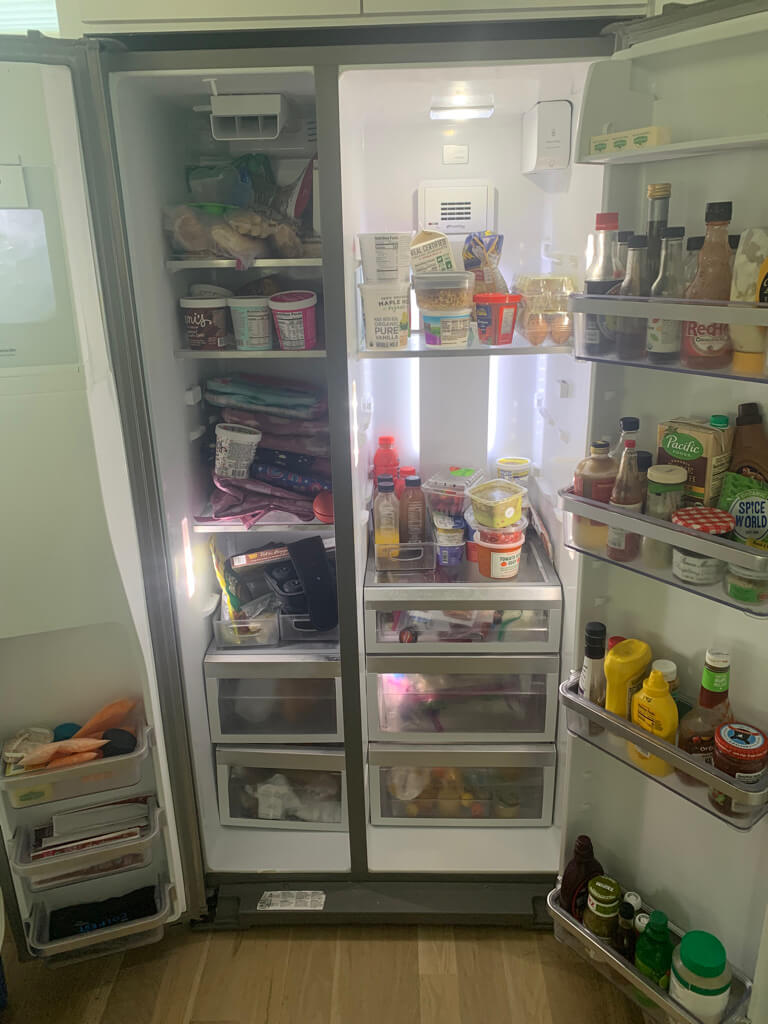
AFTER FRIDGE ORGANIZATION
One of the first things you can do is invest in clear plastic bins or containers. These will help you separate and categorize your food items, making it easier to find what you need and reducing the likelihood of food going to waste.
To optimize the use of space in your fridge, consider using lazy susans or turntables. These rotating platforms make it easy to access items at the back of the fridge without having to move everything in front.
Additionally, labeling your containers and shelves will help you and your family members find things more quickly and ensure that everything has a designated spot.
By implementing these effortless fridge organization hacks, you can say goodbye to food wastage and hello to a clean and well-organized refrigerator.
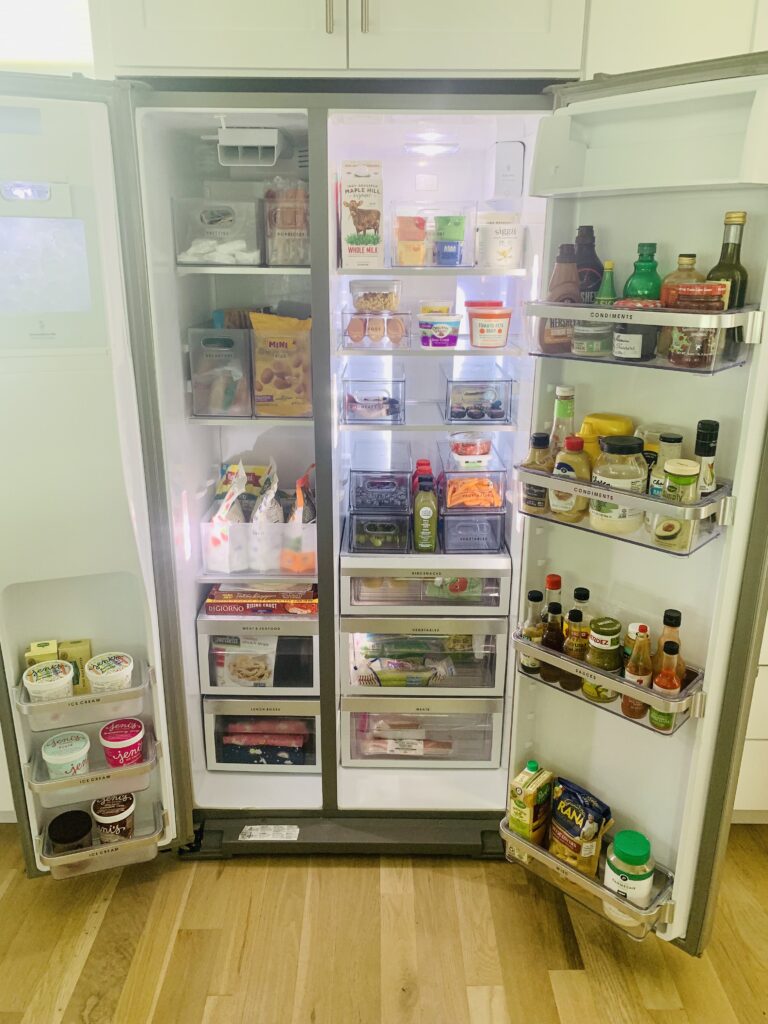
BENEFITS OF AN ORGANIZED FRIDGE
An organized fridge offers a sleuth of benefits that positively impact your daily life.
- Streamlined Cooking: Knowing exactly where ingredients save time and frustration while cooking, making the process smoother and more enjoyable.
- Reduced Stress: An organized fridge eliminates the stress of searching for items, dealing with spills, and managing expired foods.
- Cost Savings: Reduced food waste and more effective meal planning can save you money by utilizing what you have and avoiding unnecessary purchases.
- Improved Visibility: Clear visibility of items allows you to take inventory at a glance, making it easier to create shopping lists and avoid buying duplicate items.
- Family Participation: An organized fridge encourages family members to help maintain order and take responsibility for their contributions to the kitchen.
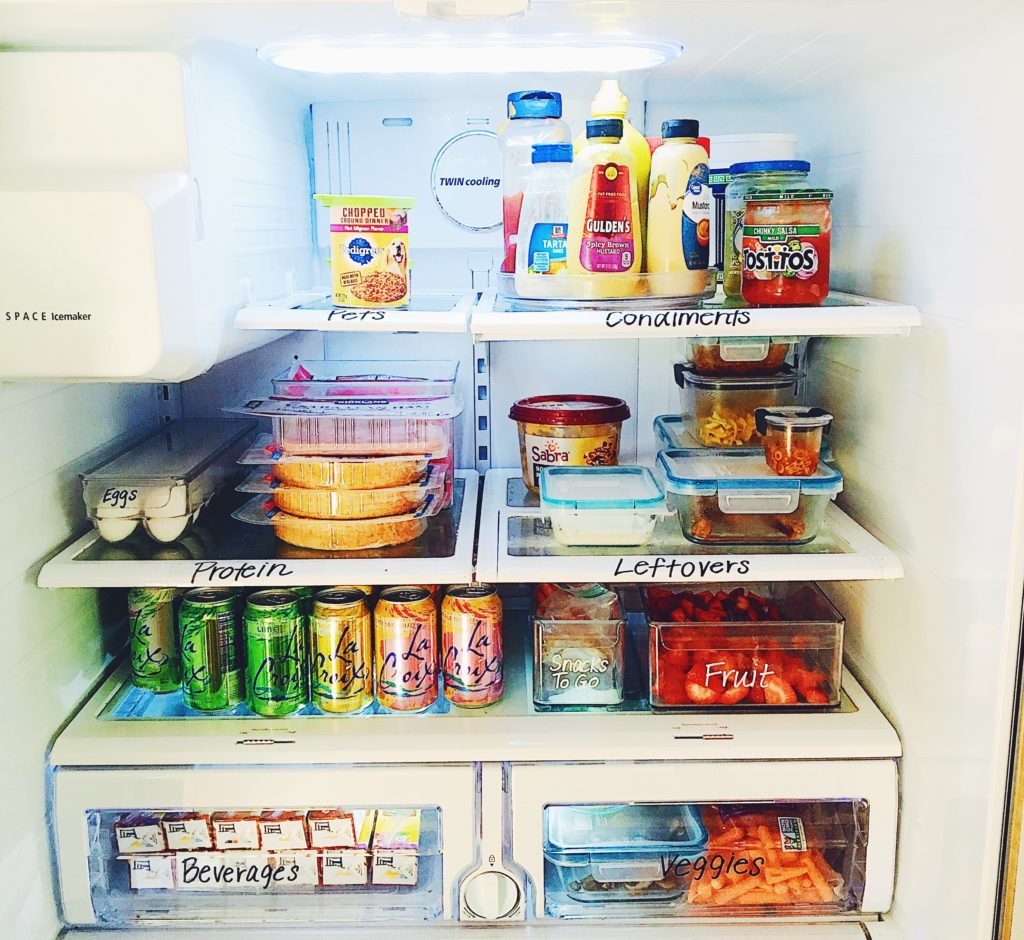
COMMON FRIDGE ORGANIZATION CHALLENGES
The fridge is one of the most frequently used appliances in the home and comes with several challenges:
- Limited Space: Small or cramped fridges may make it difficult to arrange items in an organized manner, leading to overcrowding and difficulty accessing items.
- Unsuitable Shelving: Fixed or poorly designed shelves can limit your ability to adjust storage according to your needs, causing inefficiencies in space usage.
- Lack of Visibility: Items hidden at the back of shelves are often forgotten and may go to waste.
- Temperature Zones: Fridges have different temperature zones, and understanding how to store items appropriately can be confusing. Some foods require specific temperature ranges to stay fresh.
- Frequent Grocery Shopping: If you shop for groceries frequently, it can be challenging to organize items effectively and use them before they expire.
- Leftovers Management: Storing and tracking leftovers can become chaotic, leading to waste or forgotten meals.
- Containers and Packaging: Different shapes and sizes of containers and packaging can make it tricky to stack items neatly and utilize space efficiently.
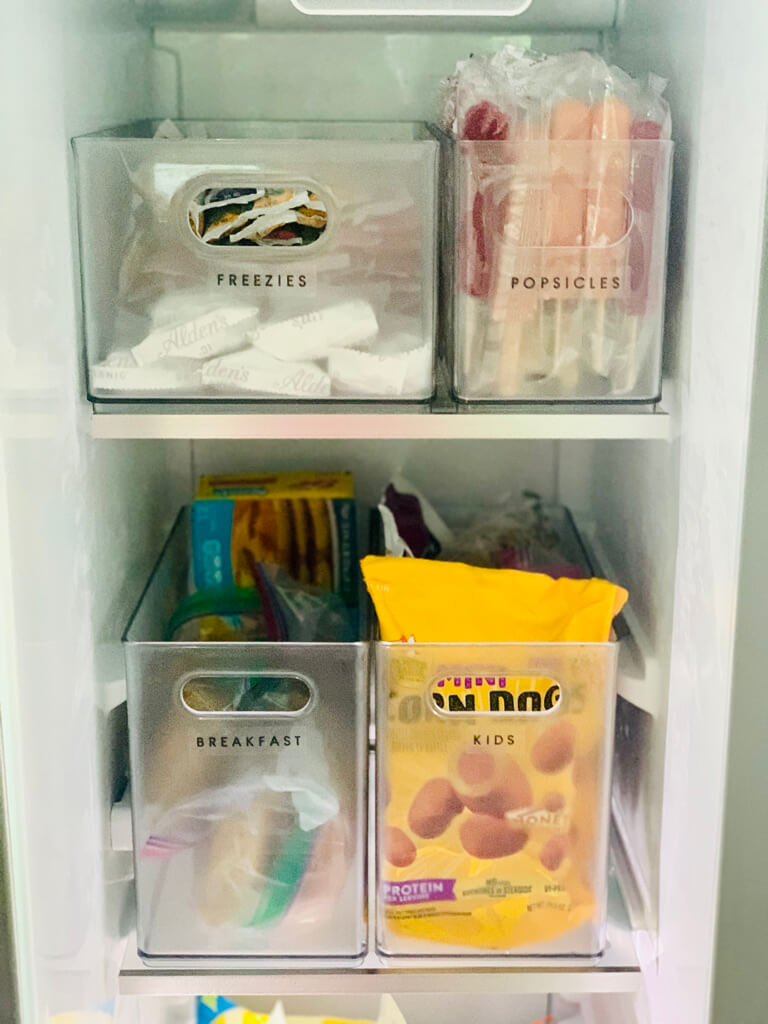
ESSENTIAL FRIDGE ORGANIZATION TOOLS AND SUPPLIES
The right products make a massive impact on your fridge organization. These are the products we recommend:
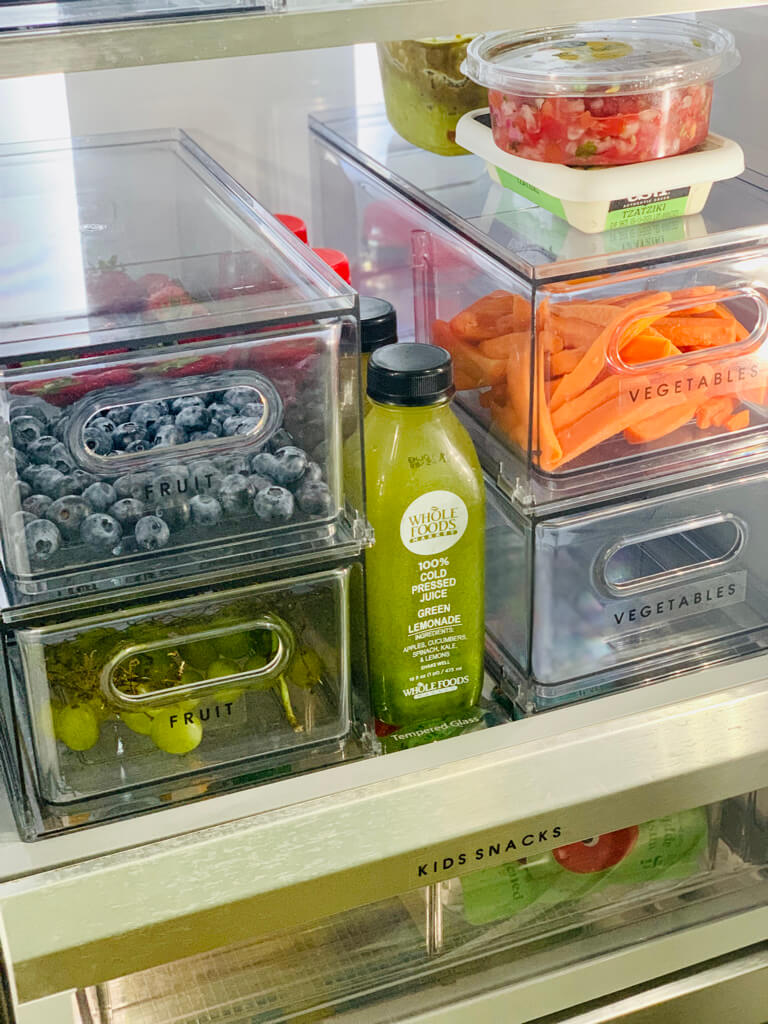
STPES TO ORGANIZING YOUR FRIDGE
- Grab a cooler. You’ll need to store perishable items in the proper temperatures so they don’t spoil.
- Empty out the fridge completely. Take it all out.
- Wipe it down. This will be one of the few times when everything will be out of the fridge, get it clean.
- Create zones with containers. Put the bins and containers in place.
- Add food back to the fridge. Backfill the containers with the appropriate categories.
- Label. Labels keep things going back to the right places.
FOOD STORAGE TIPS
To maximize the freshness and shelf life of your food items, it’s important to store them properly.
1. Dairy Products:
- Milk and dairy alternatives should be stored in their original containers on a shelf near the back of the fridge, where it’s coldest.
- Cheese should be wrapped in wax paper or parchment paper and stored in a resealable bag or airtight container to prevent moisture loss.
2. Fruits and Vegetables:
- Store fruits and vegetables separately in designated crisper drawers to prevent ethylene gas from causing premature ripening.
- Some produce items, like berries, should be stored in their original packaging or in breathable containers to maintain freshness.
3. Meat and Seafood:
- Raw meat and seafood should be stored in sealed containers or wrapped in plastic wrap to prevent cross-contamination with other foods.
- Store meat and seafood on the bottom shelf of the fridge to prevent drips onto other items.
- Use a plate or tray to catch any potential leaks from packages.
4. Leftovers and Prepared Meals:
- Allow cooked leftovers to cool to room temperature before placing them in airtight containers and storing them in the fridge.
- Consume leftovers within a few days to maintain quality.
5. Condiments and Sauces:
- Most condiments can be stored in the fridge door, where the temperature is slightly warmer.
- For homemade sauces, use airtight containers to prevent air exposure.
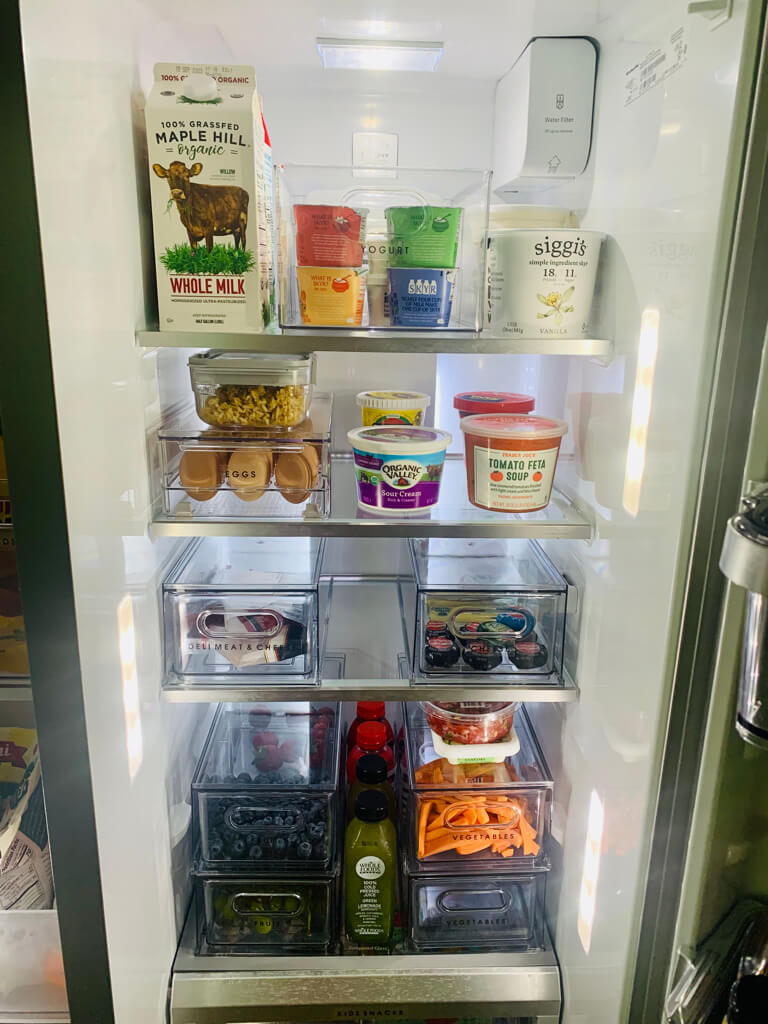
FRIDGE ORGANIZATION MISTAKES TO AVOID
Avoiding common fridge organization mistakes can help you maintain a clean, efficient, and safe storage space for your food items.
Here are some mistakes to steer clear of:
- Not labeling: Labeling is extremely important in any organizing project. Labels keep items going back to the right places.
- Overcrowding: Overfilling shelves and drawers can restrict air circulation, causing uneven cooling and potential spoilage. Leave some space between items to allow cold air to flow.
- Ignoring Temperature Zones: Fridge compartments have different temperature zones. Store items according to their needs: raw meat at the bottom, dairy and eggs in the middle, and fruits and vegetables in the designated drawers.
- Storing Hot Foods: Placing hot foods directly into the fridge raises the internal temperature, affecting other items and increasing energy consumption.
- Storing Raw Meat Over Ready-to-Eat Items: Raw meats should be stored on lower shelves to prevent any potential drips or cross-contamination with ready-to-eat foods.
- Neglecting Leftovers: Leftovers should be consumed within a few days to ensure freshness and safety. Label containers with the date of preparation to help track their age.
- Leaving Expired Foods: Holding on to expired or spoiled items can lead to unpleasant odors and the potential spread of bacteria. Regularly check expiration dates and discard items that are no longer safe to consume.
- Using the Door for Sensitive Items: The fridge door experiences more temperature fluctuations than the interior shelves. Avoid storing sensitive items like eggs and dairy in the door.

FINAL THOUGHTS
An organized fridge streamlines meal planning and minimizes food waste, making grocery shopping a breeze. With the proper system in place with labels, fridge organization is no longer a dream, it has become a reality. One reality you can start today.
+ show Comments
- Hide Comments
add a comment